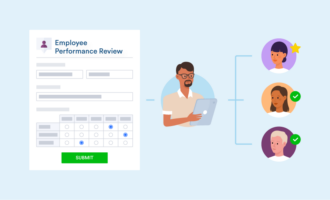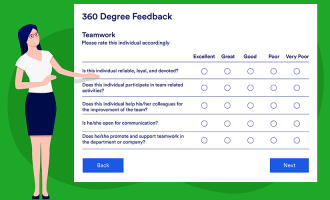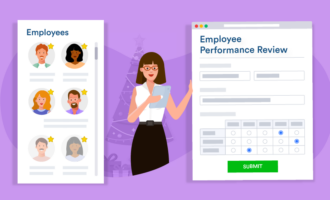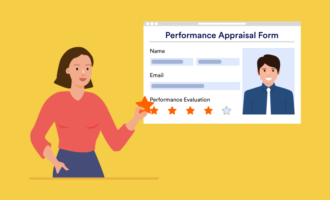Top employee retention strategies
- Increase employee engagement
- Build a culture of recognition and reward success
- Create a seamless onboarding process
- Offer benefits and survey employees to find out if your current benefits package meets their needs
- Track employee wellness and mental health and help prevent burnout
- Collect feedback from employees
- Implement regular performance reviews
- Offer competitive pay and benefits
- Provide training and professional development opportunities
- Offer flexible work arrangements
Some experts estimate that the total cost to hire a new employee can be three to four times the salary associated with their position when you factor in the soft costs of the time spent searching for candidates and covering for the vacant position’s work.
Cost is just one reason to make retaining top talent a priority in your business or organization. The right employee retention strategies can also increase worker productivity, strengthen employee morale, lead to higher revenues and profits, and help your company maintain a competitive advantage, among other positive impacts.
In this article, we’ll discuss why employee retention is important for business, share 10 effective employee retention strategies, and highlight Jotform tools and resources to help support employee retention in your organization.
An introduction to employee retention
Employee retention is an organization’s ability to keep employees and reduce turnover. While some level of employee attrition is to be expected, it’s important to keep the numbers low.
Employee retention strategies revolve around helping employers keep qualified employees for longer and reduce turnover. These strategies include maintaining a positive workplace culture that contributes to employee satisfaction, providing competitive compensation and benefits, implementing flexible policies for work-life balance, offering professional development opportunities, and granting recognition and rewards, among other things.
The reasons employee retention is so important for business
As previously mentioned, the cost of losing and replacing qualified employees is high. But it’s not just the recruiting, hiring, and training expenses associated with employee turnover that make retention essential for organizations.
Excessive employee turnover can also negatively impact productivity and performance for employees who stay, decrease employee morale, lead to diminished institutional knowledge, and even harm your company’s reputation.
On the other hand, effective employee retention strategies encourage talented employees to stay at your organization longer, which can result in increased productivity, higher levels of motivation and engagement, greater satisfaction, less work-related stress and burnout, a better brand reputation, improved business outcomes, and a superior customer experience for your end users.
10 employee retention strategies
It’s pretty difficult to overstate how important employee retention is for your business or organization. Here are 10 employee retention strategies to help your organization increase job satisfaction and reduce employee turnover.
1. Increase employee engagement
Employee engagement is an employee’s commitment to and active participation in their work with their team and company. Engaged employees are more likely to be happy in their jobs, which leads to greater productivity and longer-term employment.
Disengaged workers, on the other hand, cost trillions of dollars in lost productivity across the globe according to a 2023 Gallup report.
A favorable working environment — which can be created through recognition and rewards, regular performance reviews with actionable outcomes, competitive compensation, professional development opportunities, robust feedback systems, and other strategies — results in a positive employee experience. And that leads to engaged employees who are invested in their work and less likely to leave the organization.
It’s important to check in with your employees to measure current engagement so you can assess what’s working well and what might need to be improved. One way to measure employee engagement is with an employee engagement survey. It can help you discover how satisfied your employees are and learn more about their expectations and their day-to-day experience with your company. Then you can use the results to identify next steps.
2. Build a culture of recognition and reward success
One of the best ways to retain top talent is to show them your appreciation through a culture of recognition and rewards. Employees feel higher levels of motivation and contribute more to team and company goals when they receive recognition for their work.
There are several ways to build a culture of recognition and rewards in your organization. Here are just a few:
- Implement peer-to-peer recognition programs that allow coworkers to lift each other up for the work they do.
- Send personalized thank-you notes from team leaders and senior leadership to celebrate specific achievements.
- Publicly thank staff for their contributions in meetings and in company-wide communication channels.
- Formally recognize and reward exceptional work with bonuses, promotions, and awards.
- Celebrate work anniversaries to show company support and reward loyalty.
- Offer perks such as extra days off or flexible work arrangements.
- Create an “Employee of the Month” program. HR departments can use an employee of the month form to gather nominations from team members, track performance metrics, and select deserving individuals for recognition. This form template streamlines the process of recognizing exceptional employees and fosters a sense of appreciation and motivation within the organization.
3. Create a seamless onboarding process
Effective employee retention strategies should begin the moment a candidate accepts your job offer. When new employees experience a seamless onboarding process and receive the proper information, training, and support from day one, it sets a positive tone for their entire time at your company.
Robust, thoughtful onboarding includes educating employees on their responsibilities, training them in the appropriate job skills, introducing them to their team, setting them up with the right resources, and helping them become integrated into the company culture, among other things.
Documentation is a key part of any onboarding process. Using prebuilt onboarding templates can save your organization time and create a smooth and consistent introduction for new employees. You can use Jotform’s free employee information templates to easily collect data from new employees.
4. Offer benefits and survey employees to find out if your current benefits package meets their needs
Competitive employee benefits help increase retention. While healthcare, paid vacation, maternity and paternity leave, and retirement planning options are a few of the standard benefits most employees expect, you can also offer flexible schedules, remote work options, tuition reimbursement, paid time off for volunteer work, a pet-friendly environment, and other less traditional benefits to retain top talent.
You’ll find it easier to determine whether your current benefits package meets employee needs by using an employee benefits survey template. This survey asks employees to rate their satisfaction with their current benefits and allows them to share suggestions or comments for improvements. It’s easy to customize, share, and embed on any web page, no coding required.
5. Track employee wellness and mental health and help prevent burnout
Prioritizing employee wellness through programs that address the physical, mental, and emotional well-being of your staff helps reduce employee burnout and turnover and create a supportive work environment where everyone can flourish. Examples of employee wellness initiatives include stress management programs, reimbursement for fitness classes, extra personal days, flexible hours, financial wellness programs, and more.
Supervisors or HR representatives can use a mental health evaluation form to check on team members’ mental health concerns, or they can design an employee wellness survey with important wellness survey questions.
6. Collect feedback from employees
Seeking continuous employee feedback and being willing to hear concerns is another way to foster a positive work culture and increase retention. When employees feel like they’re listened to, they’ll feel respected and they may be more likely to try to address a problem they’re facing at work than to leave the company.
You can use an employee feedback form to collect feedback, solicit ideas and suggestions, and gauge employee satisfaction with work culture, environment, policies, and more. You can then identify ways to increase employee productivity, creativity, and satisfaction based on survey responses.
Another way to gauge how your employees are doing is with an employee pulse survey tool.
7. Implement regular performance reviews
Regular one-on-one meetings and performance check-ins with team members provide a consistent opportunity to provide employees with feedback and listen to their concerns.
Performance reviews are an opportunity to provide constructive feedback, ask employees about their professional goals, help them understand their future with the company, and share potential advancement opportunities. When employees know their job satisfaction and future with the company matter, they feel valued and are likely to stay in their positions longer.
Using a performance review template can help you standardize performance reviews, provide consistent evaluations, and ensure discussions are productive and rewarding.
8. Offer competitive pay and benefits
Talented employees are more likely to leave an organization when they don’t believe their compensation is competitive, especially when their specific skills are in high demand.
Competitive salaries increase retention, especially when paired with benefits like health insurance, retirement accounts, flexible or remote work arrangements, health club memberships or fitness class reimbursements, performance bonuses, and other perks.
9. Provide training and professional development opportunities
Professional development opportunities allow employees to develop their skills. This helps employees achieve their personal career goals and can also contribute to the organization’s success, as the company can benefit from improvements in employee performance and skill acquisition.
A byproduct of investing in the career development of your employees is greater employee retention.
Professional development opportunities include conferences and industry events, online workshops, training programs, and tuition reimbursement for continuing education and career-related courses and certifications.
10. Offer flexible work arrangements
An especially effective way to boost employee retention is through offering flexible work options, such as flextime to accommodate commitments outside work, remote and hybrid work arrangements, shorter workweeks, and so on.
Flexible work arrangements foster more work-life balance. When employees are given options to balance their personal and professional lives, they tend to be happier in their work and less likely to quit their jobs. In fact, flexible work arrangements have been shown to increase employee engagement and retention.
The 10 methods above are just the start. Other employee retention strategies include
- Maintaining open and clear communication
- Building a positive company culture in which employees feel supported, valued, and respected and that their contributions matter
- Training effective leaders
- Creating clear expectations
- Emphasizing teamwork
- Developing mentorship programs
- Being respectful and inclusive
The many ways Jotform can help support employee retention
Jotform is a powerful tool for measuring employee engagement and satisfaction and tracking retention. Easily design employee feedback surveys with customizable templates or from scratch with an easy-to-use, drag-and-drop interface. When you’re done, share your surveys over email, link, or website embed.
Jotform also helps you organize and analyze survey responses. Jotform Tables automatically stores form submissions in a database format, while Jotform Report Builder lets you automatically generate visual reports based on survey responses.
You can even create an employee app to centralize important forms in a single location, no coding knowledge required, when you use Jotform Apps. You can use our customizable employee app template to host satisfaction forms, feedback forms, company policy documents, and more. Apps can be accessed and downloaded from any device.
Plus, there’s Jotform Enterprise, a comprehensive platform for teams to collect, manage, and share data. Teams can create custom online forms in minutes from scratch or by using any of our 10,000-plus templates. Leverage hundreds of software integrations to connect your tech stack. Collect information, payments, e-signatures, and more, and add custom branding to your forms. Manage your data and multiple users from a centralized admin console.
Jotform’s powerful suite of tools can help you measure employee satisfaction and increase retention. Try it for free today.
Photo by Andreea Avramescu on Unsplash



























Send Comment: